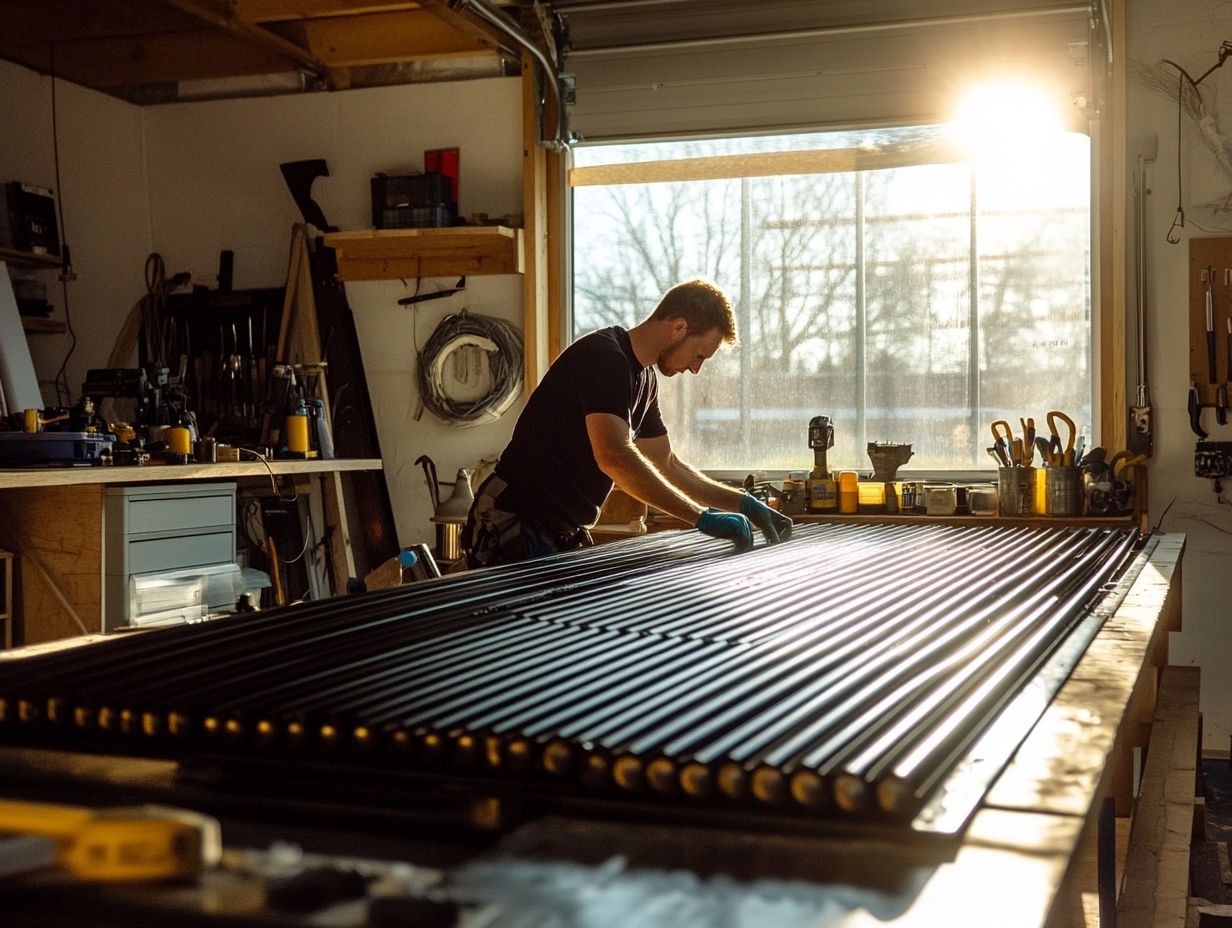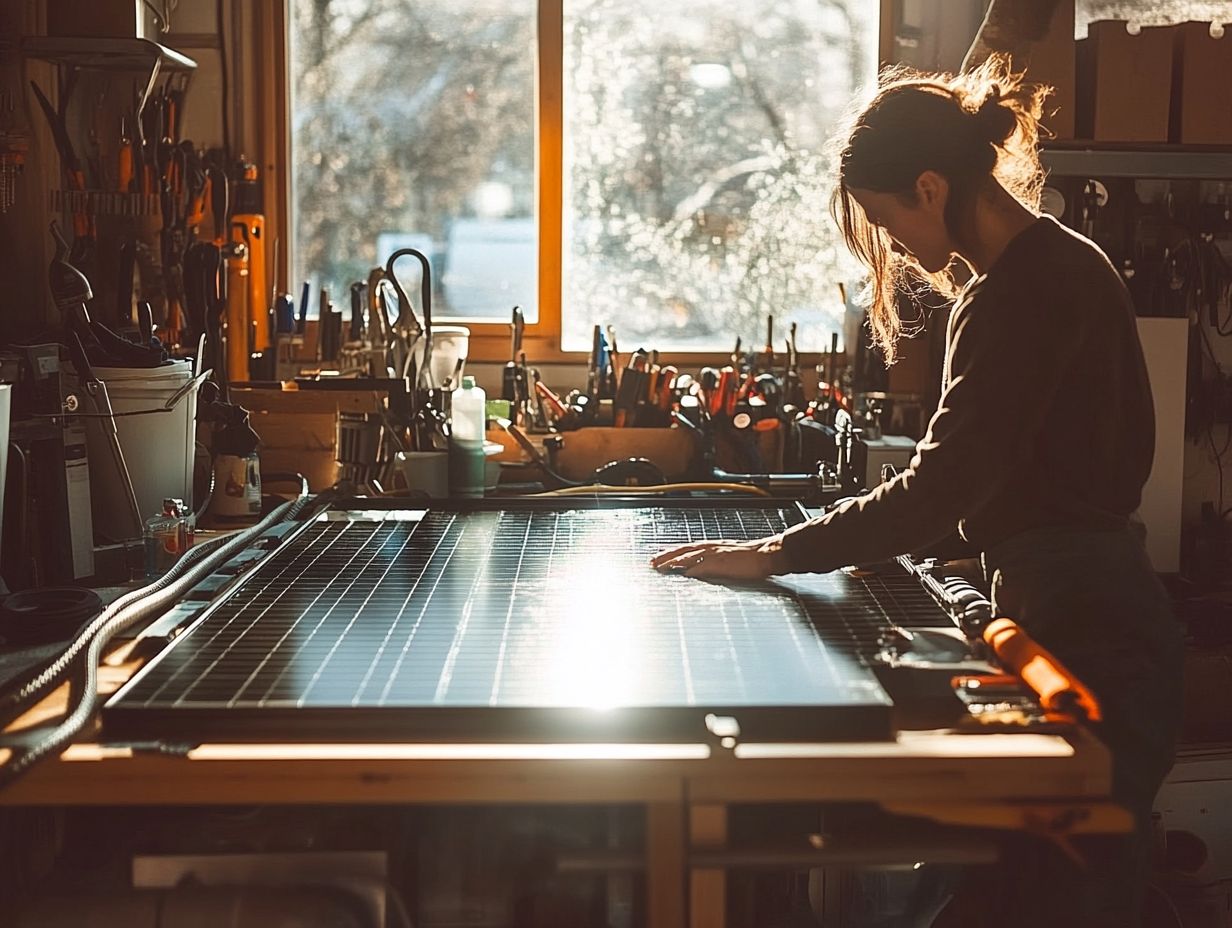Creating Homemade Solar Heating Panels
Homemade solar heating panels offer a cost-effective way to harness solar energy for heating your home, water, or even a DIY solar pool heater. Get ready to transform how you heat your home!
You ll discover benefits like significant cost savings and a positive impact on the environment. This guide covers the essential materials and tools you need.
It also provides step-by-step instructions to build your own panels. Plus, you’ll find maintenance tips to maximize their efficiency.
You can also find other ways to use solar heating in your home. Prepare to revolutionize your energy strategy!
Contents
- Key Takeaways:
- Benefits of Using Homemade Solar Heating Panels
- Materials and Tools Needed for Your DIY Solar Project
- Step-by-Step Guide to Building Homemade Solar Heating Panels
- Maintenance and Troubleshooting
- Alternative Uses for Homemade Solar Heating Panels
- Frequently Asked Questions
- What materials are needed to create homemade solar heating panels?
- How much does it cost to create homemade solar heating panels?
- Do I need to have special skills or knowledge to create homemade solar heating panels?
- What is the benefit of creating homemade solar heating panels?
- How much energy can homemade solar heating panels generate?
- Are there any safety concerns when creating homemade solar heating panels?
Key Takeaways:

- Save money and reduce your environmental impact by creating homemade solar heating panels.
- With the right materials and tools, building these panels can be a rewarding project.
- Regular maintenance and troubleshooting help ensure efficiency. Consider other uses for solar energy at home, like a DIY solar pool heater or water heater.
What are Homemade Solar Heating Panels?
Homemade solar heating panels are systems designed to capture energy from the sun for heating. They use common materials like soda cans, black paint, and PVC pipe.
These DIY solar heaters work by generating hot air using the principles of thermodynamics and solar absorption. They can effectively warm spaces like home studios and greenhouses.
By using these eco-friendly solutions, you can reduce your energy bills and carbon footprint. Constructing solar air heaters involves layering materials to maximize heating efficiency.
For instance, black polyurethane provides excellent insulation, while corrugated plastic offers a lightweight framework. Thermal batteries can boost heat retention and usage.
These panels capture sunlight and convert it into warm air for your space. This technology is affordable and sustainable, making it a great option for both homes and farms.
Benefits of Using Homemade Solar Heating Panels
The advantages of homemade solar heating panels are remarkable. Enjoy significant savings on energy bills and a positive impact on the environment.
By using renewable energy sources, you enhance your heating system and support local businesses focused on sustainability. You can take control of your energy consumption.
This helps you significantly lower your overall carbon footprint.
Cost Savings and Environmental Impact
Using homemade solar heating panels can lead to significant cost savings over time by reducing or even eliminating your heating bills. This allows you to channel those savings into other areas of your home or into savings for future needs. Imagine the freedom of knowing you re generating your own heat! This eco-friendly initiative isn t just about saving money; it actively contributes to a reduction in carbon emissions, demonstrating how DIY projects can harness solar technology for a sustainable future.
This system also helps with energy storage, effectively managing your heat demand during cold winter months.
By diving into such innovative projects, you can enjoy a remarkable return on investment, as the initial costs of materials and assembly are often eclipsed by the substantial reductions in your energy expenses over the years. These solar panels not only enhance your energy independence but also shield you from the unpredictable nature of utility costs, aligning your personal savings with broader ecological benefits.
Each installation you undertake plays a role in mitigating greenhouse gas emissions. Embracing homemade solar technology enables you financially while championing a collective movement toward renewable energy solutions.
In doing so, you strengthen your community’s efforts in the fight against climate change, paving the way for a brighter, more sustainable future. This also aligns with the mission of organizations like Fair Companies and environmental advocates such as Sami Grover and Peter Rowan. Start your project today and take control of your energy future!
Materials and Tools Needed for Your DIY Solar Project

When embarking on the journey of constructing your own solar heating panels, it’s essential to gather a diverse array of materials and tools. You’ll need building materials such as corrugated plastic, black paint to enhance solar absorption, and utility pumps or irrigation tubing to ensure the efficient circulation of hot air.
A thoughtfully designed solar collector, an insulation box, and components that enhance thermal mass (the ability of a material to store heat) are crucial for maximizing the heating efficiency of your DIY solar heater. If you’re interested in further enhancing your project, check out this guide on how to make a homemade heat pump. By selecting the right supplies, including materials from reliable community organizations, you set the stage for a successful heating project that can endure a variety of weather conditions.
List of Necessary Supplies
As a well-prepared do-it-yourselfer, you ll want to compile a specific list of essential supplies for constructing your homemade solar heating panels. Gather key materials such as PVC pipe, black paint for optimal solar absorption, and an insulation box to maintain heating efficiency. Tools like a KSD301 thermostat and 12v fans will significantly enhance the functionality of your solar heater, creating a more effective heating process that meets your unique needs. You can also reference video screen captures from DIY projects to better understand construction techniques.
Plus these primary items, it’s crucial to include a large sheet of clear polycarbonate or acrylic glazing. This not only protects the panel’s components but also allows sunlight to penetrate efficiently, boosting heat accumulation. You may also want to consider using copper tubing for your heat transfer system, as its exceptional conductivity ensures rapid heating. Don t forget some durable screws and brackets to securely assemble the entire frame. Consult resources from the University of Hull and the University of Copenhagen for advanced DIY solar heater designs and efficiency tips.
Investing in high-quality insulating foam can also be advantageous, as it minimizes heat loss during operation. Each of these components plays a vital role in ensuring your final product operates at peak efficiency, allowing you to harness solar energy effectively and with confidence. Also, ensure that your solar panels are suitable for various climate conditions, from hot summers to cold winters.
Step-by-Step Guide to Building Homemade Solar Heating Panels
Building your own solar heating panels is an exciting project that can change the way you heat your home! This innovative DIY project allows you to harness readily available materials to create something truly functional. For those interested in sustainable heating, following these steps ensures that your solar technology is efficient and environmentally friendly.
At the core of this system lies the solar collector, expertly crafted to capture radiant heat from sunlight and convert it into usable energy for space heating. By carefully following detailed building instructions, you ensure that the heating process is both efficient and optimized for peak performance. Exploring DIY passive solar heating techniques can further enhance your approach to sustainable energy solutions.
Instructions and Tips for Construction
Constructing a DIY solar heater demands meticulous attention to detail. Following specific instructions boosts heating efficiency. Make use of screen collectors and take into account the prevailing weather conditions when positioning your panels. This maximizes sunlight exposure and utilization, ensuring optimal heat generation across varying climates.
Opt for materials that provide excellent insulation and minimize heat loss, such as reflective sheet materials or energy-saving glass, to enhance your system’s performance. Insulate the pipes to prevent freezing during colder months. Using adjustable angle mounts allows you to capture the sun’s rays more effectively throughout the seasons. For advanced setups, consider integrating home insulation strategies that complement using solar energy for heating water in your solar heating system.
Don’t overlook the importance of integrating a thermostat to optimize your heater s performance, enabling automatic adjustments based on indoor temperatures. These enhancements help your solar heater operate more efficiently while offering increased durability, ensuring longevity and dependable energy savings. You can also incorporate passive solar design principles to further enhance the system s performance and sustainability.
Maintenance and Troubleshooting

Maintaining and troubleshooting your homemade solar heating panels is essential for ensuring their longevity and reliable performance within your solar technology heating system. Consulting case studies from experts like Peter Rowan or a Seattle man who successfully implemented DIY solar solutions can provide valuable insights.
Keep your panels in top shape with these maintenance practices:
- Cleaning the panels
- Inspecting for leaks
- Monitoring heating efficiency
These proactive steps will help you prevent common issues and significantly extend the operational life of your system.
Tips for Keeping Panels Efficient and Functional
To ensure your homemade solar heating panels remain efficient and functional, embrace best practices that enhance both performance and durability. Regularly inspect your solar panels for dirt or debris, implement maintenance routines that include cleaning and adjustments, and monitor the heating system for any signs of inefficiency. For a visual guide, video screen captures of similar DIY solar projects can be extremely helpful.
Establishing a seasonal cleaning schedule can greatly enhance your panels’ ability to capture sunlight effectively. Use a soft brush or a hose with moderate pressure to gently remove any accumulated dust or leaves, ensuring that the surface remains unharmed. Don’t forget to inspect the mounting structures and connections for any signs of corrosion or wear, as these issues can significantly impact overall performance. For improved heating efficiency, consider using black paint to enhance solar absorption and prevent heat loss.
Investing in monitoring systems allows for real-time data tracking, helping you detect any variations in energy output. By keeping tabs on performance metrics, you can swiftly address any issues and maintain optimal heating efficiencies during colder months. A KSD301 thermostat, which helps regulate temperature, can improve your overall system’s efficiency.
What materials are you planning to use for your solar heater? Follow these steps today to make your own solar oven and start saving on energy costs!
Alternative Uses for Homemade Solar Heating Panels
Homemade solar heating panels present a wealth of versatile applications that extend far beyond simple space heating. You can explore various alternative uses. Consider crafting your own solar pool heaters or creating solar water heaters as effective options. Discover other sustainable heating solutions as well. For instance, using soda cans in your solar air heater is a simple DIY project that increases heat storage and generation.
By effectively harnessing solar energy, you can generate heat for many purposes. This approach boosts your energy efficiency while contributing to a greener environment. For those interested in DIY projects, guidelines for building your own solar panel provide useful instructions for maximizing your system’s heating potential.
Other Ways to Utilize Solar Energy at Home
You can explore numerous ways to harness solar energy at home, expanding the advantages of sustainable heating solutions while actively contributing to renewable energy initiatives. Whether it s installing solar panels for electricity generation or utilizing solar thermal energy (the heat energy from the sun) for heating water and powering irrigation systems, these methods align perfectly with community organizations’ goals to enhance energy efficiency and promote eco-friendly living.
Solar air heaters can significantly reduce your dependency on conventional heating systems during the cold winter months. Try solar-powered lighting systems! They can brighten your outdoor spaces without relying on conventional electricity. This not only significantly reduces your utility bills but also lightens your carbon footprint.
Solar technology has advanced to the point where incorporating solar-powered utility pumps and greenhouse heating systems makes your household even more energy-efficient. Incorporating solar water heaters offers an eco-friendly solution for everyday tasks like bathing and dishwashing. This makes your daily routines more sustainable.
These systems can be further enhanced by adding insulation boxes and passive solar heating principles to retain heat more effectively. Act now by investing in smart solar systems to boost your efficiency! They enable you to monitor energy usage and optimize performance through advanced technology.
By participating in local solar co-ops, you can share resources and experiences while gaining access to bulk purchasing discounts. This creates a sense of community and collectively advocates for greener practices. Consider using thermal batteries for efficient energy storage and maintaining heat demand during periods of low sunlight.
Frequently Asked Questions
What materials are needed to create homemade solar heating panels?
The materials needed to create homemade solar heating panels include solar cells, a backing board, a frame, a sheet of glass or plastic, and a silicone sealant. You might also consider using corrugated plastic and black polyurethane for better solar absorption and durability.
How much does it cost to create homemade solar heating panels?
The cost of creating homemade solar heating panels can vary depending on the size and materials used, but it can range from $100 to $500. Building materials like insulation and black surface materials can affect the overall expense while improving the heating efficiency of your panels.
Do I need to have special skills or knowledge to create homemade solar heating panels?
While some basic DIY skills are helpful, you do not need any specialized knowledge or skills to create homemade solar heating panels. There are many tutorials and guides available online to help you through the process. Learning about thermodynamics and heating principles can be beneficial but is not necessary for beginners.
What is the benefit of creating homemade solar heating panels?
Creating homemade solar heating panels can help you save money on your energy bills and reduce your carbon footprint. It also allows you to have more control over the design and customization of your solar heating system. This heating project can turn you into an environmental do-gooder, making a positive impact on the climate.
How much energy can homemade solar heating panels generate?
The energy output from DIY solar heating panels varies based on location, weather, and panel size. Typically, these panels can generate around 1,000 watts of energy for every square meter. Understanding your local climate helps you optimize performance!
Are there any safety concerns when creating homemade solar heating panels?
Creating DIY solar heating panels is generally safe if you take proper precautions. Always wear protective gear and follow safety guidelines when working with electrical components. Check resources from universities like the University of Hull or the University of Copenhagen for detailed safety tips.







